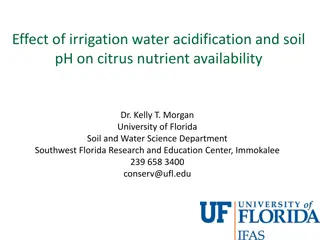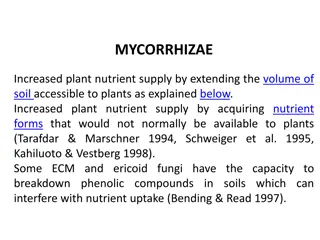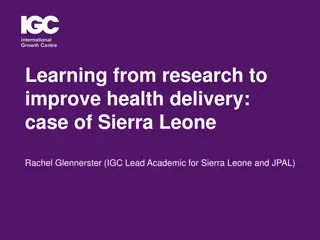Nutrient Uptake in Bacteria: Mechanisms and Factors
The process of nutrient uptake in bacteria, including the role of macronutrients, micronutrients, and environmental factors. Learn about the different mechanisms of nutrient transport and the importance of selective permeability in plasma membranes.
0 views • 25 slides
Improving Flu Vaccination Uptake: 2023/24 Toolkit for GP Practices
This toolkit provides guidance for GP practices in South West England on improving flu vaccination uptake for eligible children and adults. It includes strategies to increase vaccination rates, setting up flu programmes, recalling patients, and maximizing opportunities to co-administer vaccines. The
4 views • 16 slides
Mycorrhizal Association and Its Importance in Water Mining
Mycorrhizal association plays a crucial role in facilitating nutrient and water absorption for plants through a symbiotic relationship with fungi. This relationship enhances the plant's ability to acquire minerals from the soil while providing essential compounds to the fungi. The mycorrhizal associ
4 views • 6 slides
Uptake of Viral Load Testing and Viraemic Episodes During Pregnancy in Johannesburg, South Africa
This study investigates the uptake of viral load testing and frequency of viraemic episodes during pregnancy among HIV-positive mothers in Johannesburg, South Africa. Data from a cohort of mothers and infants born at a local hospital were linked to laboratory data for analysis. The results show the
2 views • 12 slides
Understanding Water Absorption in Plants: Mechanisms and Implications
Exploring the intricate process of water absorption in plants, this course delves into the active and passive methods used by roots to uptake water from soil, the role of osmosis in osmotic active absorption, the influence of transpiration on passive absorption, and the significance of root hairs in
1 views • 26 slides
Concept of Foliar Nutrition
Explore the crucial concepts of foliar nutrition, including the role of droplet size in nutrient entry and the importance of wetting agents in optimizing nutrient absorption in plants. Discover how smaller droplets enhance efficiency while avoiding drift, and how wetting agents facilitate water upta
0 views • 8 slides
Grape Pomace Utilization in Soil Nutrient Management Study
Study on the mobility of total carbon, nitrogen, and polyphenols from grape pomace in soil columns, focusing on its relevance as an organic fertilizer rich in nutrients. The research also highlights the industrial potential of grape pomace, nutrient mobility between varieties, and methods used for c
1 views • 14 slides
Nutrient Recycling in Ecosystems
Nutrient recycling in ecosystems involves the continuous breakdown and exchange of elements between living and non-living components, ensuring sustainability and no long-term drain on Earth's nutrients. This process includes decomposition of organic material by bacteria and fungi, uptake of nutrient
1 views • 23 slides
Understanding Citrus Nutrient Availability in Relation to Soil pH and Irrigation Water Acidification
This research by Dr. Kelly T. Morgan from the University of Florida explores the impact of soil pH, irrigation water acidification, and nutrient recommendations on citrus trees affected by HLB disease. The study examines the availability of key nutrients such as Mn and Zn, the effects of different s
0 views • 23 slides
Effects of Micronutrients on Maize Grain Yield and Macronutrients Uptake
Micronutrients play a vital role in promoting strong and steady growth in crops like maize, leading to higher yields and improved harvest quality. This study aims to assess the impact of micronutrient supplementation, specifically Cu, Fe, and Zn, on maize grain yield and the uptake of macronutrients
0 views • 15 slides
Enhancing Nutrient Efficiency in Agriculture for Sustainable Systems
Improved nutrient use and manure management are crucial for sustainable agricultural systems. Efforts to increase nutrient efficiency through better practices can help reduce emissions and aquatic pollution. Public awareness, policy realignment, and soil data quality enhancements are key areas for p
0 views • 14 slides
Harnessing Phosphate-Solubilizing Microorganisms for Sustainable Crop Growth
Phosphorus is crucial for plant growth, but its availability is often limited due to insoluble forms in soil. The use of phosphate-solubilizing microorganisms (PSMs) can help convert insoluble phosphorus into a usable form for plants. This process involves isolating, screening, and mass-producing PS
0 views • 6 slides
Mechanisms of Nutrient Uptake by Microbial Cells
Nutrient uptake by microbial cells involves various transport mechanisms such as passive diffusion, facilitated diffusion, active transport, and group translocation. These mechanisms ensure the specific acquisition of required nutrients by the cell through the selectively permeable plasma membrane.
3 views • 15 slides
Understanding Nutrient Pollution and Its Impact on the Environment
Nutrient pollution, characterized by the excess input of nitrogen and phosphorus into water and air, is a significant environmental issue with far-reaching consequences. It can lead to toxic algae blooms, dead zones, economic losses, and adverse effects on human health. The causes of nutrient pollut
2 views • 11 slides
Regional E-Mobility Policy Roadmap for PICs: A WB Study
The World Bank commissioned a study to develop a regional e-mobility policy roadmap for the Pacific Island Countries (PICs), focusing on the feasibility of large-scale electric vehicle (EV) deployment. Assessing e-mobility status, grid impact, cost-benefit analysis, and policy recommendations, the s
0 views • 23 slides
Benefits of Mycorrhizae in Plant Nutrition and Ecosystem Health
Mycorrhizae play a crucial role in enhancing plant nutrient uptake, protecting against pests, improving plant growth, and fostering ecosystem stability. These symbiotic relationships provide various benefits such as increased nutrient supply, protection from pathogens, enhancement of plant growth fo
0 views • 9 slides
European Standards for Plant Biostimulants Development
The European Committee for Standardization (CEN) plays a crucial role in developing European standards for plant biostimulants, focusing on improving plant nutrition processes independently of nutrient content. The CEN/TC.455 committee is responsible for creating standards supporting the EU Fertilis
2 views • 5 slides
Insights into Cultural Participation in School and Beyond
Young people's exposure to cultural activities, such as music, occurs within formal education, extracurricular programs, and outside of school. Provision and participation in music education vary across schools, influenced by factors like school size, student demographics, and curriculum design. The
0 views • 16 slides
Kenya PrEP Ring Rollout Scenarios Analysis
Analysis conducted by the PROMISE Consortium in January 2022 highlights the prioritized counties for introducing the monthly dapivirine ring as an HIV prevention method for women in Kenya. The scenarios consider HIV incidence among women and current oral PrEP uptake across counties to determine the
0 views • 9 slides
Evaluating a Behavioural Science Approach for Increasing Advice Service Uptake
Derbyshire County Council is evaluating a behavioural science approach to enhance the uptake of advice services for residents in economic hardship. The project focuses on increasing caller referrals to support agencies, using Randomised Controlled Trials (RCTs) to evaluate interventions' impact and
2 views • 13 slides
Nutrient Criteria Development Plan for High Rock Lake Summary Update
Nutrient Criteria Development in North Carolina has evolved through various stages since 2001, with the key milestones being the development of the Nutrient Criteria Implementation Plan in 2004 and the Nutrient Criteria Development Plan in 2014. The plan aims to link nutrient concentrations with the
0 views • 8 slides
Iowa Nutrient Pollution Control Measures and Strategies
Gulf Restoration Network Decision, sources of Nutrients Nitrogen (N) and Phosphorus (P), impacts of Nutrient Pollution leading to Algae Blooms and Gulf Hypoxia (Dead Zone), measures to reduce Non-Point Source (NPS) contamination, EPA's current strategy, and Iowa's approach with its Nutrient Reductio
0 views • 20 slides
COVID-19 Vaccination Uptake in Ireland - Week 47, 2022 Report
The weekly report for Week 47, 2022 in Ireland shows the vaccination uptake percentages for Primary Course Completed (PCC), 1st Booster, 2nd Booster, and 3rd Booster across different age groups. As of Week 47, the vaccination rates vary among age groups, with the highest uptake seen in the 65+ years
0 views • 16 slides
Update on COVID-19 Vaccine Uptake in Tennessee as of October 8, 2021
In this update, Tennessee reports an increase in COVID-19 vaccine uptake with 52.8% having at least one dose and 46.7% fully immunized. The state ranks 40th in vaccine administration per 100K population. Vaccine hesitancy is addressed, and dates of FDA committee meetings on booster authorizations an
0 views • 15 slides
Listen, Innovate, Reach: Enhancing Vaccine Uptake Strategy in Fiji
Fiji faced challenges with low vaccine uptake despite intensified communication efforts. The solution involved establishing a dedicated Social Listening Subgroup to gather feedback from various sources and inform operational strategies. This approach led to improved understanding of community sentim
0 views • 5 slides
Enhancing Tuberculosis Diagnostics Uptake in Kenya: Insights and Solutions
This study delves into the uptake of new tuberculosis diagnostics in Kenya, revealing challenges such as limited access and staffing issues. It highlights preferential coverage of certain diagnostic methods and identifies barriers to utilization, including health system challenges and low disease su
0 views • 10 slides
Understanding Biological Uptake of Trace Elements in Natural Systems
Explore the connection between stoichiometric plasticity and trace metal distribution, investigate microbial acquisition systems, analyze modes of metal uptake, and address co-limitations and interactions within organisms. Utilize molecular tools to enhance knowledge on trace element bioavailability
0 views • 5 slides
COVID-19 Vaccination Uptake in Ireland - Weekly Report Week 33, 2022
The weekly report on COVID-19 vaccination uptake in Ireland for Week 33, 2022, ending on August 21st, 2022, highlights the percentage uptake of fully vaccinated individuals, booster doses, and doses for immunocompromised individuals across different age groups. The data is continuously updated as va
0 views • 11 slides
Fathers' Uptake of Leave and Childbearing Intentions in South Korea
This presentation explores the correlation between fathers' uptake of leave and intentions for continued childbearing in South Korea, comparing findings from other countries. It discusses the impact of paid and unpaid work hours, gender role attitudes, and patterns of fathers' leave uptake in differ
0 views • 18 slides
Addressing the Measles Outbreak: UKHSA's Response and National Campaign Launch
Measles cases are rising in England, particularly in London, with a concerning low vaccination rate. UKHSA predicts high risk in London and nationwide, urging for intervention to prevent further spread. A national campaign focusing on MMR vaccine uptake is set to launch on 14th July, targeting low u
0 views • 10 slides
PrEP Uptake Among Female Sex Workers in Zimbabwe During COVID-19 Lockdown
Hypothesized peer-led community-based provision of PrEP services positively influenced PrEP uptake among female sex workers in Zimbabwe. Despite national commodity shortages, PrEP initiation rates peaked at 51% in September 2020, with 33.7% of 19,407 sex workers initiating PrEP. The highest initiati
0 views • 9 slides
Factors Associated with COVID-19 Vaccine Uptake Among Hospital-Admitted Health Workers in South Africa (2020-2022)
This preliminary analysis by Jonathan Ramodike explores factors influencing COVID-19 vaccine uptake among health workers in South Africa. The study aims to understand vaccination rates, determinants, and the impact on hospital admissions. Data from over 6,000 health worker records were analyzed to a
0 views • 13 slides
Role of Cell Cycle in Nanoparticle Uptake and Dilution in Cell Population
The cell cycle plays a crucial role in the cellular uptake and dilution of nanoparticles within a cell population. This process involves different phases such as G1, S, G2, and M, each with specific functions related to cell growth, DNA synthesis, protein synthesis, and cell division. Understanding
0 views • 20 slides
Understanding Facilitators and Barriers to Seasonal Malaria Chemoprevention Uptake in Nigeria
This qualitative study conducted by the National Malaria Elimination Programme in Nigeria aimed to identify factors influencing the uptake of Seasonal Malaria Chemoprevention (SMC) among children aged 3-59 months in selected states. The study explored caregivers' knowledge, experiences, and attitude
0 views • 12 slides
Understanding Manure Management: Compositions, Nutrient Losses, and Factors
Explore the complexities of manure management by delving into manure compositions, nutrient losses, and the various factors influencing the quality and quantity of manure. Learn about the impact of animal species, diets, and management practices on manure characteristics, as well as strategies to mi
0 views • 29 slides
Understanding Nutrient Cycling in Soil for Sustainable Agriculture
Explore the intricate processes of nutrient cycling in soil, with a focus on nitrogen (N) and phosphorus (P) balances. Discover the various inputs and outputs considered within different scales, from field to country level. Gain insights into the importance of interpreting data correctly and the imp
0 views • 22 slides
Learning from Research to Improve Health Delivery in Sierra Leone
Challenges in health delivery in Africa include low uptake of cost-effective prevention, leading to underinvestment in healthcare. Research suggests making prevention convenient and cost-effective can improve uptake. Lessons learned from post-war recovery highlight the importance of incentivizing pa
0 views • 15 slides
FAIRsFAIR.INFRAEOSC.5c.call Proposal Summary
FAIR uptake and compliance in all scientific communities, coordinate initiatives across member states and associated countries, develop and implement measures on FAIR data policies, support organization and participation on FAIR uptake and compliance, support the co-development and implementation of
0 views • 42 slides
Nutrient Watershed Permit Stakeholder Advisory Group Meeting Overview
The Nutrient Watershed Permit Stakeholder Advisory Group Meeting on December 6, 2013, discussed permit components, effluent monitoring, annual reporting, treatment optimization, nutrient studies, monitoring, reporting, support for nutrient studies, treatment plant optimization, and permit timeline.
0 views • 6 slides
Nutrient Conceptual Model Review Summary
Comments and feedback on a Nutrient Conceptual Model report include suggestions to address issues related to eutrophication concepts, nutrient stoichiometry, community composition, and nutrient reduction goals. Recommendations also focus on incorporating flushing/residence time discussions, predicti
0 views • 9 slides







































